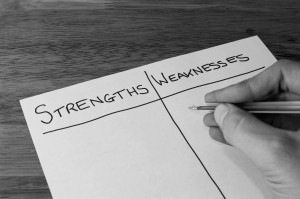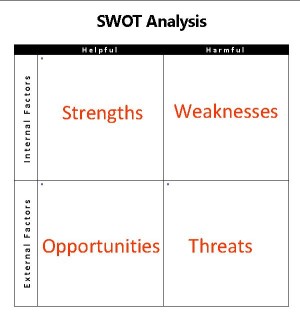
Have you done your personal SWOT analysis?
Organizations frequently do SWOT analyses because they are effective tools for reflection and planning. Individual leaders can and should gain the same benefits.
While there are many tools and processes to engage during the creation of a strategic plan, none is so time honored as the SWOT analysis. The classic SWOT analysis examines the Strengths, Weaknesses, Opportunities and Threats that face an organization. It is the basis of a solid strategic planning process because a good SWOT analysis forces an organization to realistically assess the internal factors and market conditions that may potentially assist or thwart the organization in the achievement of its goals.
Last week when I worked with an organization on their strategic planning process, each leader delivered a SWOT presentation for their department. Everyone benefited as the other leaders asked questions and offered additional perspectives.
This week I am preparing to facilitate a mastermind of a group of entrepreneurs wanting to plan the coming year for their businesses and – you guessed it – I have suggested that they each prepare a SWOT analysis to discuss with the other participants. I am forecasting that each entrepreneur will learn something about themselves and their business just by taking the time to reflect and receive feedback in the four dimensions.
All this made me wonder why individual leaders don’t do their own personal SWOT analyses for reflection and learning and then use them for career planning and personal development. Although the process is most often used by senior teams of organizations, it is perfectly adaptable and beneficial for individual leaders.
 Here’s how it works. Think of the intrinsic things that make you who you are as a leader. Differentiate these things as assets and liabilities or strengths and weaknesses. These are the things about you that facilitate your successful leadership and those that make leadership more difficult or hold you back. These go in the top of the chart under their corresponding headings.
Here’s how it works. Think of the intrinsic things that make you who you are as a leader. Differentiate these things as assets and liabilities or strengths and weaknesses. These are the things about you that facilitate your successful leadership and those that make leadership more difficult or hold you back. These go in the top of the chart under their corresponding headings.
‘Outgoing and comfortable around people’ and ‘great at visualizing the big picture’ might be classified as strengths.
‘Direct to the point of often hurting people’s feelings’ or ‘slow to take action in a crisis’ may be weaknesses.
Then go to the bottom of the chart to those factors that are influenced by external forces and think about those that that may help or hinder you.
‘Company opening new business lines requiring more leaders’ or ‘stable and talented staff freeing me up to take on new responsibilities’ may be an opportunity.
‘Reduced demand for my area of specialty’ is a threat in most people’s careers, as is ‘increased competition for fewer jobs.’
Preparing a personal SWOT analysis is a great way to self-reflect. If you are truly honest with yourself it will enable you to identify those factors, both internal and external, to capitalize on and assist you in creating a road map for further development.


